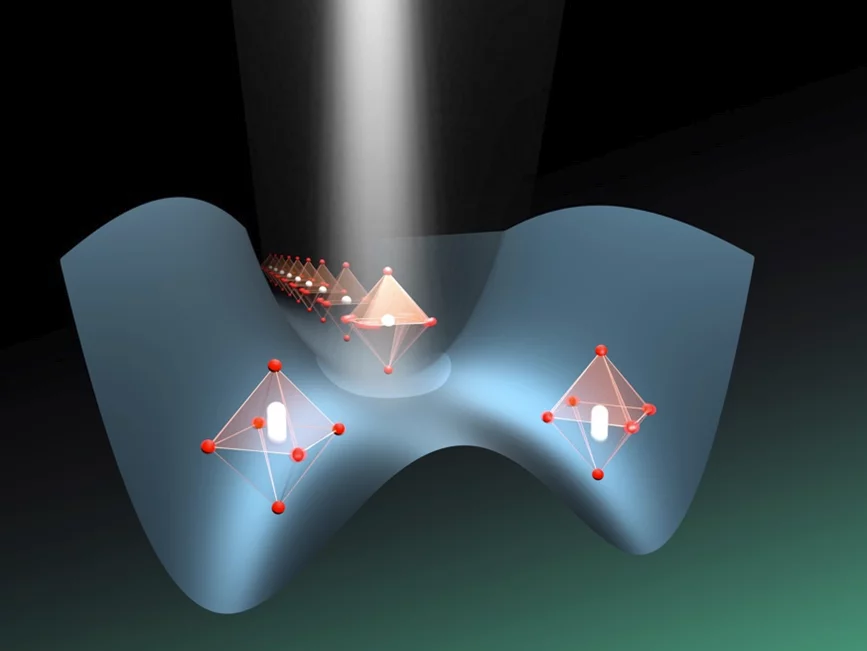Terahertz frequency laser pulses are a powerful tool to manipulate the properties of quantum materials through tailored modifications of their crystal structure. Light-induced ferroelectricity in SrTiO3 is a remarkable demonstration of these physics. Under mid-infrared illumination, this material transforms into a state of permanently ordered electrical dipoles, which are absent in its equilibrium phase diagram. A team of researchers from the Max Planck Institute for the Structure and Dynamics of Matter (MPSD, Germany), SLAC National Accelerator Laboratory (USA) and PSI performed an experiment at the Bernina beamline of the SwissFEL X-ray Free Electron Laser to identify the intrinsic interactions relevant to creating this state. The new insight was gained not by detecting the position of the atoms, but by measuring the fluctuations around these atomic positions. The result provides evidence that these fluctuations are reduced, which may explain why the dipolar structure is more ordered than in equilibrium, and why a ferroelectric state could be induced. 1
Ferroelectric materials are characterized by the spontaneous parallel alignment of electric dipoles, leading to a macroscopic polarisation that can point in two opposite directions. The pointing direction can be switched by an electric field, enabling use of ferroelectrics in the digital storage and processing components of modern electronic devices.
Strontium titanate, SrTiO3, is a so-called quantum paraelectric. Unlike many of the ferroelectric materials, SrTiO3 lacks a macroscopic ferroelectric state. Yet, abundant experimental evidence shows that quantum fluctuations of the crystal lattice prevent the long-range order to develop.
In 2019 optical measurements found that SrTiO3 transforms into a ferroelectric when certain vibrations of the crystal lattice are excited by intense pulses in the mid-infrared2. At the time, the nonlinear response of the crystal lattice was speculated to be the origin of this effect, resulting in the formation of strain that helps the material to become ferroelectric. However, direct measurements of the strain, and even more importantly of the fluctuations of the atomic positions on the earliest timescales after the mid-IR excitation impact were lacking.
Now, the researchers combined the mid-infrared excitation with femtosecond x-ray pulses from the SwissFEL free electron laser to shine light on these dynamics, which take place on the sub-picosecond time scale – shorter than a trillionth of a second. They detected the diffuse scattering arising from disorder in the atomic arrangement, which is sensitive to fluctuations, in other words noise, of the crystal lattice.
Experimentally the team found that the fluctuations of certain rotational modes in the SrTiO3 lattice, which obstruct the formation of long-range ferroelectricity, were rapidly reduced by the pulsed mid-infrared excitation. Such suppression does not occur in this material in equilibrium and hints at the origin of the light-induced ferroelectricity. This was confirmed by a rigorous theoretical analysis that revealed complex, high-order interactions between a set of lattice vibrations and the strain as the source of these observations.
The fact that certain lattice fluctuations, which prevent the formation of long-range ferroic order, can be suppressed by dynamic means is new and offers possibilities for similar behavior in other quantum materials. Furthermore, the results discussed here may have wider implications beyond the physics of SrTiO3, including switching of magnetic phases and enhancement of superconductivity.
Contact
Dr. Roman Mankowsky
Beamline scientist Bernina
Paul Scherrer Institute PSI
+41 56 310 56 86
roman.mankowsky@psi.ch
Original Publication
1: Quenched lattice fluctuations in optically driven SrTiO3
Fechner, M., Först, M., Orenstein, G., Krapivin, V., Disa, A.S., Buzzi, M., Von Hoegen, A., De La Pena, G., Nguyen, Q.L., Mankowsky, R., Sander, M., Lemke, H., Deng, Y., Trigo, M., Cavalleri, A.
Nature Materials, 23 (2024), 363–368.
https://doi.org/10.1038/s41563-023-01791-y
related publication
Nova, T.F., Disa, A.S., Fechner, M., Cavalleri, A., 2019. Metastable ferroelectricity in optically strained SrTiO 3.
Science 364 (2019), 1075–1079.
https://doi.org/10.1126/science.aaw4911
For further details, see also https://www.mpsd.mpg.de/835801/2024-02-ferroelectricity-fechner
